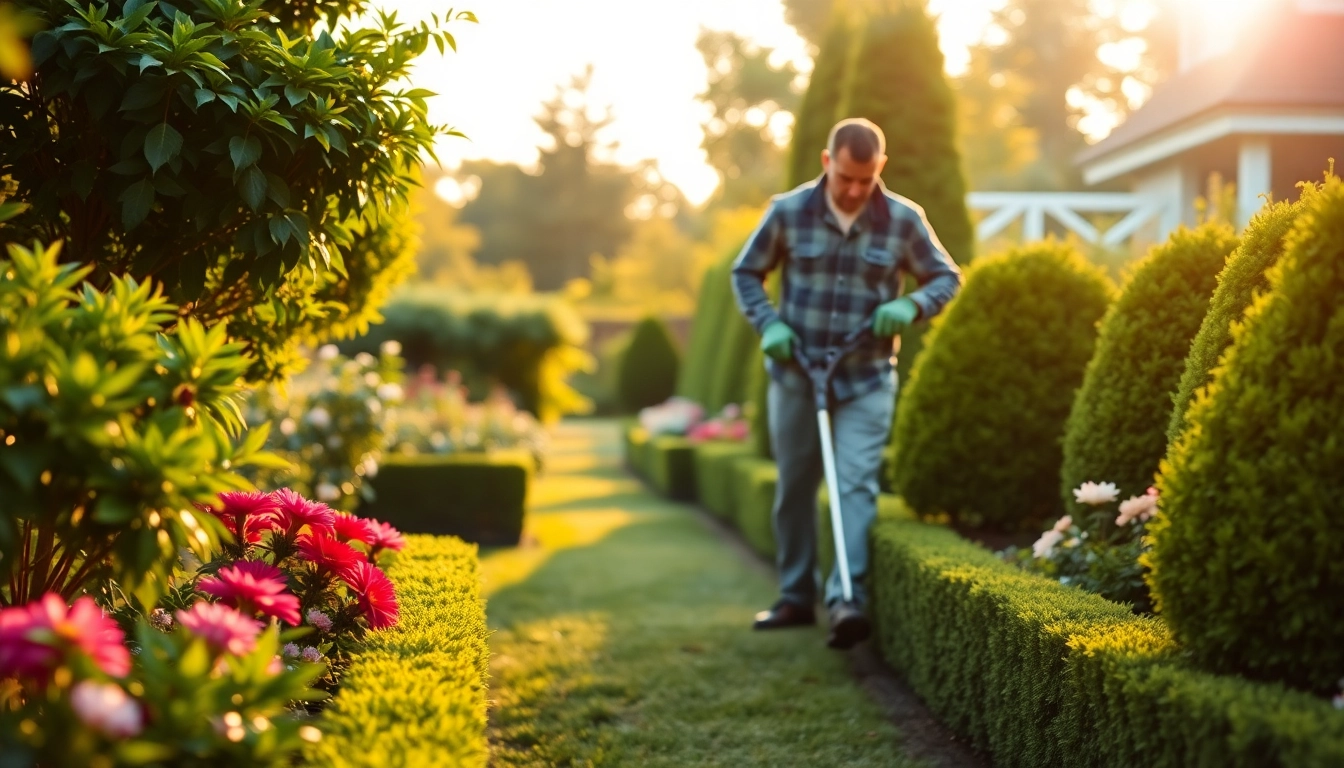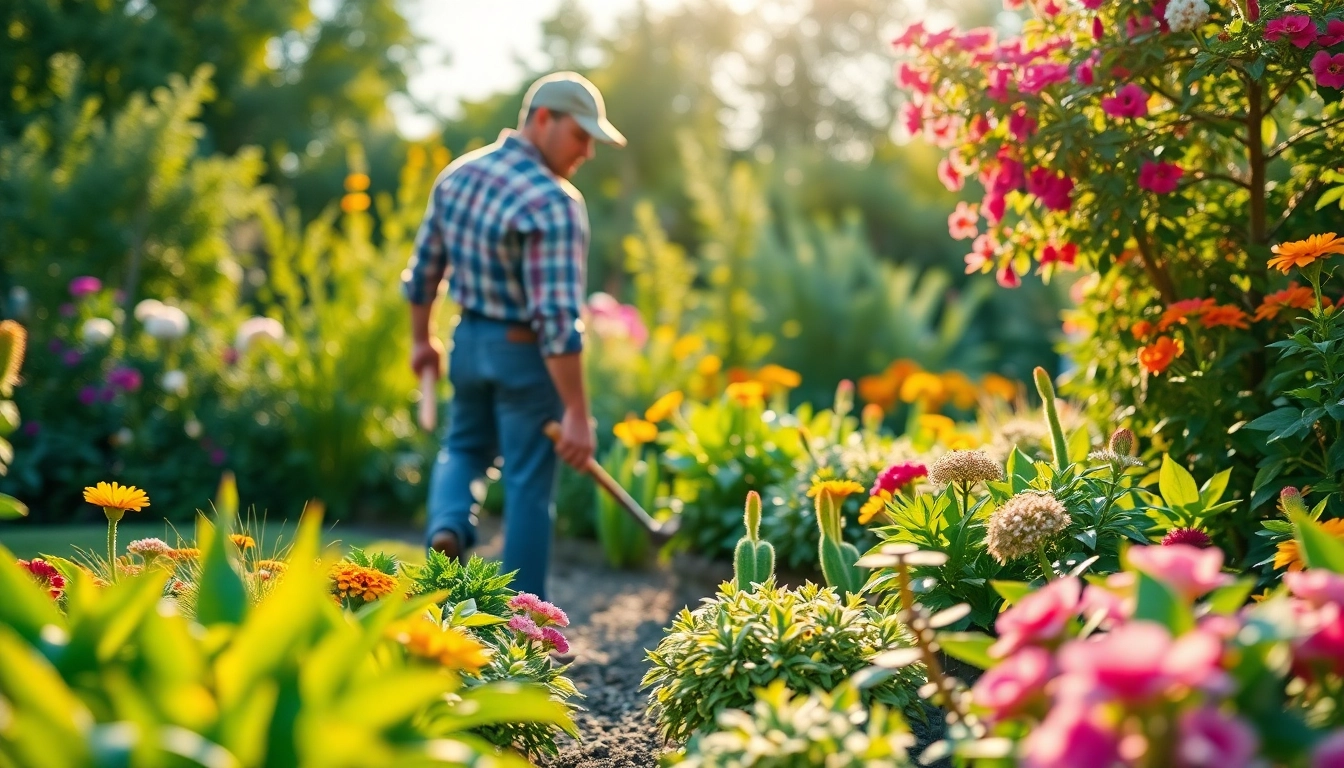Understanding Garden Maintenance Services
What is a Garden Maintenance Service?
A garden maintenance service encompasses a variety of professional tasks designed to keep your outdoor space thriving and aesthetically pleasing. This service typically includes regular lawn care, landscaping, pest control, and seasonal clean-ups. Unlike one-time landscaping projects, garden maintenance focuses on ongoing care and upkeep, ensuring that plants and lawns remain healthy throughout the seasons. Professional services can vary significantly depending on the provider and your specific needs, ranging from basic lawn mowing to comprehensive garden planning and care strategies.
Benefits of Professional Garden Maintenance
There are numerous benefits to enlisting professional garden maintenance services. Firstly, it saves you time and effort. Maintaining a garden requires a considerable commitment, and busy schedules can make this challenging. With experts handling the details, homeowners can focus on enjoying their outdoor spaces without the stress of upkeep.
Professionals bring knowledge and experience to the table. They can identify problems early, suggest solutions, and apply treatments more effectively than many DIY efforts. Moreover, professional services can enhance the aesthetic appeal of your home, increasing curb appeal and property value.
Another advantage is consistency. Regular maintenance ensures that gardens look their best all year round, adapting care to the specific needs of the seasons. By using a garden maintenance service, homeowners can also receive tailored advice and solutions that match their unique gardens’ needs and conditions.
Choosing the Right Service for Your Needs
Selecting the right garden maintenance service is crucial for effective garden care. Start by researching local providers and checking reviews. Look for companies with experience in the specific services you need, whether it’s lawn care, pest management, or landscape design.
Consider requesting quotes and consultations to understand what services they offer and their pricing structures. It’s important to clarify what’s included in the service package. A reputable service should offer a detailed breakdown of tasks, service frequency, and any additional costs for extra services. Additionally, ask about their staff’s training and whether they use eco-friendly practices or products, especially if you have children or pets.
Core Elements of Garden Maintenance
Regular Lawn Care Practices
Regular lawn care practices are foundational to the overall health of any garden. This includes mowing, fertilizing, watering, and aerating. Mowing should be done at the right height suitable for the grass type. For instance, Kentucky bluegrass requires a height of about 2.5 to 3 inches for optimal health. By mowing regularly, you encourage denser growth and can reduce weed proliferation.
Fertilization schedule is essential, too. Many homeowners overlook it, yet it can be the difference between a lush green lawn and a patchy one. Using a slow-release fertilizer in spring and fall provides the nutrients required for vigorous growth. In addition, proper watering techniques—ideally deep and infrequent to encourage root development—play a pivotal role in lawn vitality.
Plant Health and Pest Control Techniques
Ensuring plant health is equally important. Regularly inspect plants for signs of disease or pest infestations. Techniques such as integrated pest management (IPM) combine biological, cultural, and chemical practices that are safer for the environment while being effective against pests. Identifying the pest early can prevent extensive damage and reduce the need for more harmful pesticides.
Organic solutions, such as neem oil or insecticidal soaps, should be prioritized to maintain a healthy ecosystem within your garden. Additionally, implementing companion planting can create a natural pest deterrent. For example, planting marigolds alongside vegetable crops can help deter nematodes and other harmful insects.
Seasonal Cleaning and Preparation
Seasonal cleaning and preparation are critical components of effective garden maintenance. In the spring, services typically include removing winter debris, such as fallen leaves and branches, and evaluating plant health after winter dormancy. This is also the time for pruning, dividing perennials, and preparing garden beds for new plantings.
During fall, focus shifts to preparing for winter. Clearing away dead plants, mulching to protect perennials, and even planting cover crops can protect the soil from erosion and aid in nutrient replenishment. Regular seasonal preparation not only promotes a healthy garden but also provides a structured approach to annual gardening tasks, allowing for a thriving garden year-round.
DIY vs. Professional Services
When to Hire a Garden Maintenance Service
Deciding whether to engage a professional or to maintain your garden yourself can depend on several factors, including your experience level, available time, and garden size. For smaller gardens or simple landscaping, DIY maintenance can be manageable. However, larger spaces often require tools and expertise that surpass personal capability.
If you notice persistent problems—such as chronic pest infestations, poor soil health, or lack of design coherence—it may be time to seek professional help. Moreover, if you desire specific enhancements to your garden, such as a new flower bed or pond installation, turning to experienced landscapers will yield better results than trial and error.
Cost Considerations for Professional Help
The costs associated with professional garden maintenance can widely vary based on the range of services you require. Standard services like mowing and trimming often come at a lower cost, whereas large projects that require design and installation can have significantly higher rates.
On average, homeowners might expect to pay anywhere from $30 to $80 per hour for lawn care, depending on their region. Package deals can offer savings if regular services are bundled. It’s also essential to examine the overall value. While DIY methods may seem cost-effective initially, consider factoring in the time and potential for mistakes that could cost more in the end.
Key Tools for DIY Garden Maintenance
Equipping yourself with the right tools is crucial for effective DIY garden maintenance. Essential tools include a quality lawn mower, pruning shears, a rake, and a garden hoe. Additionally, having a proper watering can or hose, fertilizer spreader, and compost bin can help maintain plant health.
Investing in high-quality tools may come with a higher upfront cost, but they can last for years with proper care. Moreover, learning how to use them correctly—along with safety practices—can significantly enhance your gardening experience, making it efficient and rewarding.
Trends in Garden Maintenance
Sustainable Practices for Modern Gardens
As environmental awareness grows, sustainable practices in garden maintenance are becoming more popular. Homeowners are increasingly focused on conserving resources while maintaining their gardens. This may include using native plants that require less water and are better adapted to local conditions, as well as implementing xeriscaping techniques to reduce irrigation needs.
Utilizing organic fertilizers and pest control methods can also contribute to eco-friendly gardening. Composting kitchen scraps and yard waste to create nutrient-rich soil amendments is another sustainable practice that supports garden health while cutting down on waste disposal.
Technology’s Role in Garden Maintenance Services
Technology is revolutionizing garden maintenance, making it more efficient and accessible. Smart irrigation systems, which adjust watering schedules based on weather forecasts, allow for water conservation while keeping gardens well-hydrated. Similarly, apps that monitor plant health and growth can keep gardeners informed and proactive about their plants’ needs.
Even robotic lawn mowers are gaining popularity, offering a hands-off approach to lawn care. These devices navigate yards, ensuring even and efficient mowing without human intervention. Such innovations not only save time but can also enhance the quality of maintenance, leading to healthier gardens.
Current Styles and Landscaping Trends
In terms of aesthetics, various styles in landscape design continue to evolve, from modern minimalism to lush, tropical gardens. The trend is increasingly leaning toward creating multi-functional outdoor spaces that can serve as areas for entertainment, relaxation, and food production. Incorporating edible plants into traditional landscaping is a growing trend, blending beauty with practicality.
Landscapes that foster biodiversity, featuring a mix of plants that attract wildlife and pollinators, are highly desirable. Homeowners are looking for ways to create personalized, sustainable outdoor havens that reflect their individual tastes while also serving ecological purposes.
Evaluating the Success of Your Garden Maintenance Plan
How to Measure Growth and Health of Plants
Monitoring plant health is vital for the continuous success of your garden. Several indicators can reveal how well your plants are thriving. Regularly inspect leaves for discoloration, spots, and curling, which can signify issues such as pests or disease. Growth rate should also be measured against seasonal expectations; stunted growth may indicate soil nutrient deficiencies or poor growing conditions.
Pay attention to blooming cycles, as flowering plants should typically align with their expected seasons. Keeping a garden journal to track changes and conditions over time can provide invaluable insights into overall plant health.
Common Indicators of Need for Service Reevaluation
There are several signs that may suggest it’s time to reevaluate your garden maintenance plan. If specific areas show consistent wilt, yellowing leaves, or an influx of pests, it may indicate that strategies need adjustment. Additionally, a lack of flowering in plants that should bloom can point to issues with care or improper planting.
Similarly, if you notice a significant increase in weeds or if your garden seems unmanageable despite your efforts, it may be time to consult a professional service. Regular assessments can ensure your garden continues to meet both your aesthetic and functional expectations.
Setting Goals for Your Garden’s Development
Establishing clear goals for your garden’s development is essential for maintaining focus and enthusiasm. Set realistic, achievable targets based on your garden’s requirements and your personal preferences. Goals might range from aesthetic improvements, such as creating a vibrant flower bed, to functional objectives like increasing vegetable yields.
Review your goals periodically and adjust them as necessary based on the current state of your garden. Engaging in community gardening workshops or following gardening blogs can provide inspiration and new ideas to incorporate into your plan, ensuring continuous growth and satisfaction.



